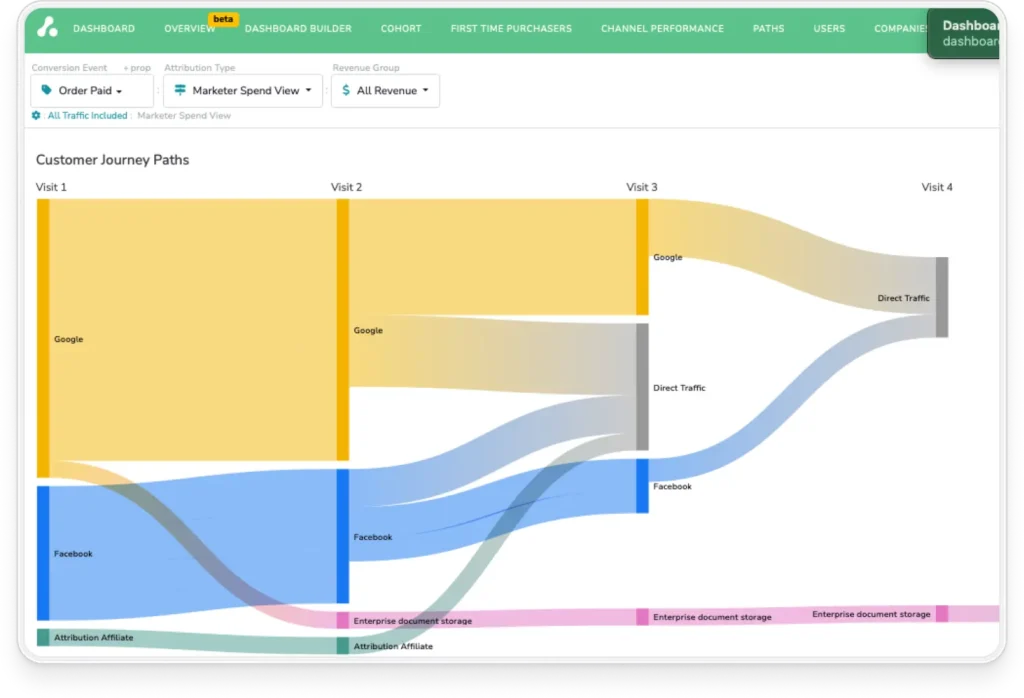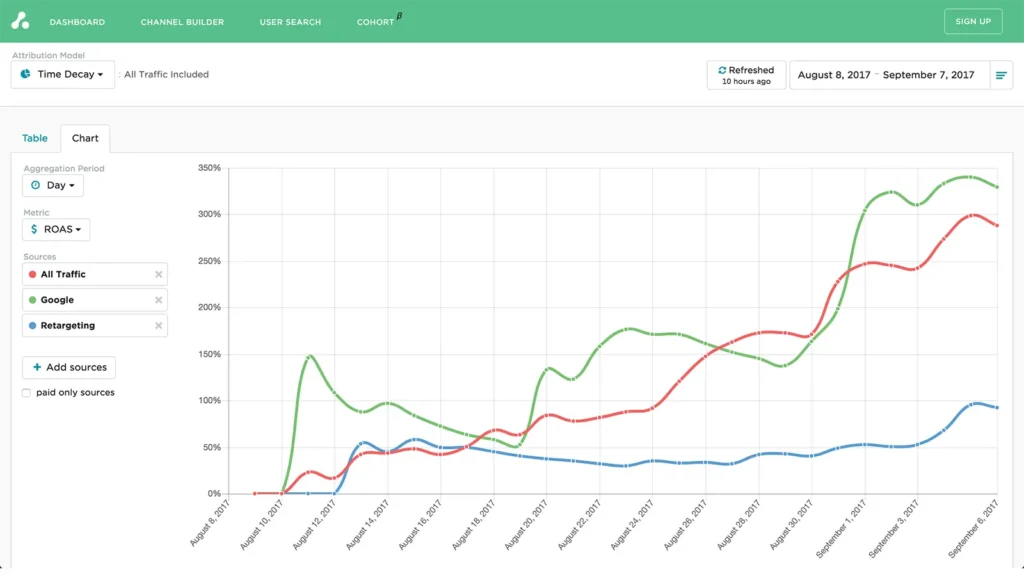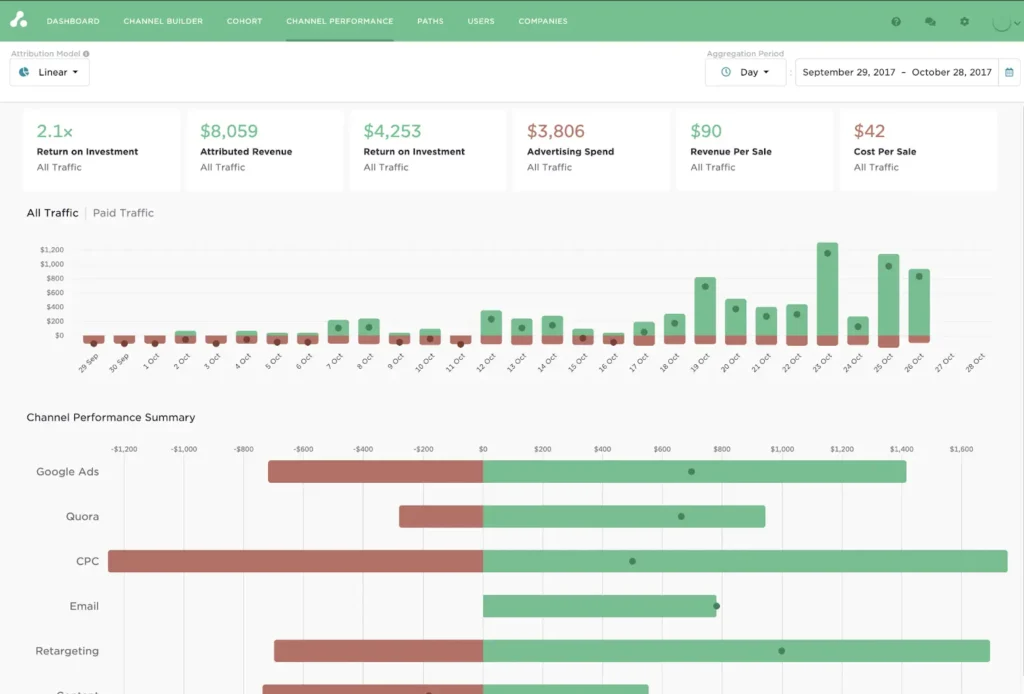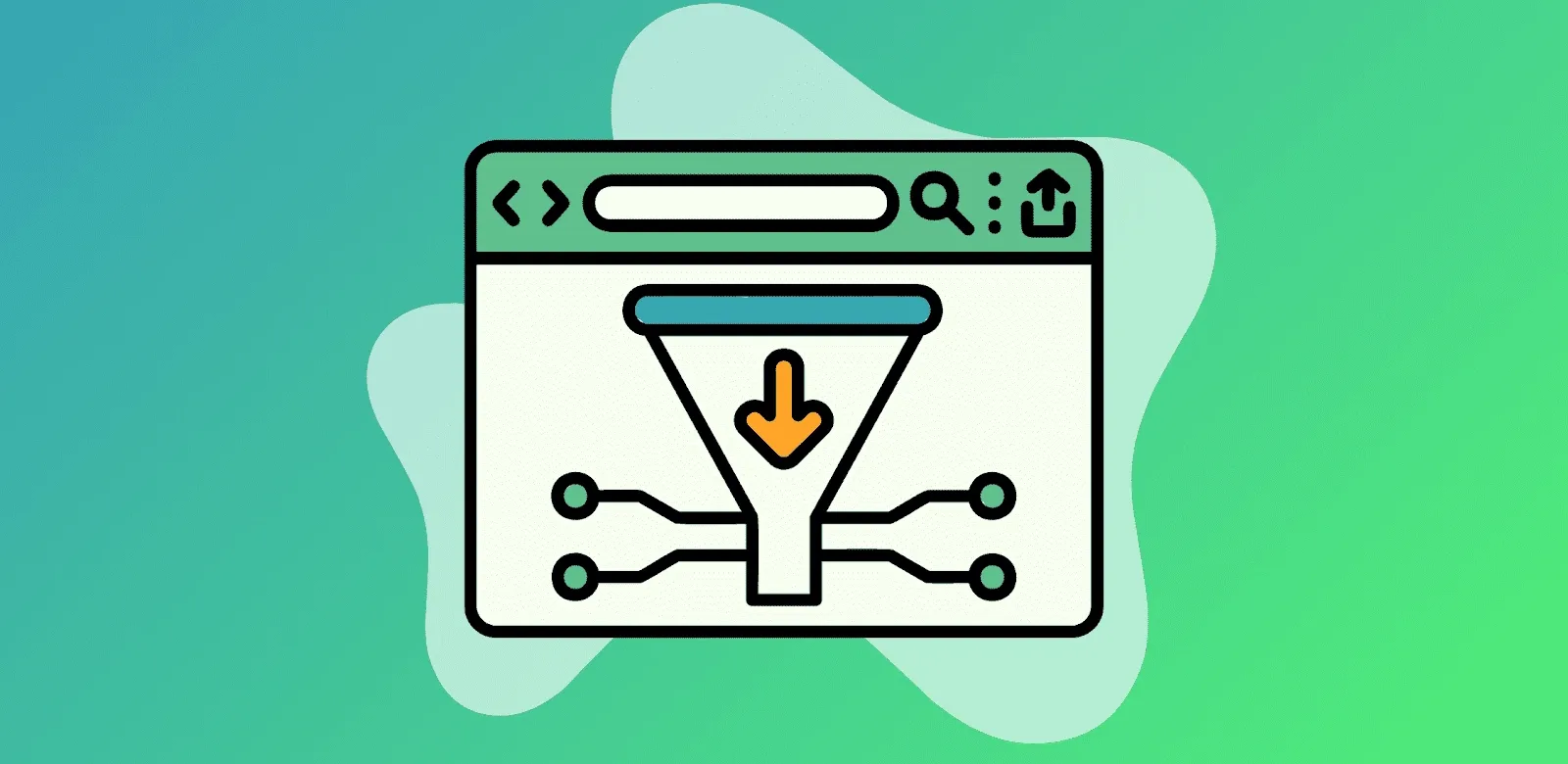If you’re serious about marketing and revenue growth, simply having a customer acquisition funnel isn’t enough. You need in-depth visibility, rigorous audits, and continuous optimization.
In this guide, we’ll teach you how—but first, here’s a quick refresher on customer acquisition funnels:
A customer acquisition funnel is a framework that marketers use to track the flow of customers through defined stages of a customer journey. It’s typically made up of four stages:
- Awareness: When the customer becomes aware of your brand.
- Consideration: When they begin to research your product/services, reviews/testimonials, compare with competitors, etc.
- Conversion: When they’ve decided to become a customer of your brand.
- Retention: When they begin building a long-term relationship with your brand, becoming a loyal customer.
For each of these stages, we’ll show you step-by-step how to:
- Identify the right KPIs.
- Map your funnel.
- Audit for drop-off points and optimize tactics.
- Optimize your tools and data sources.
How to Build, Audit and Optimize Your Customer Acquisition Funnel
Now that we’ve revisited the fundamentals, it’s time to focus on practical steps to audit, map, and optimize your customer acquisition funnel. Let’s start at the beginning: identifying the right metrics to measure your funnel performance.
Step 1: Identify the Right Customer Acquisition Metrics
To effectively measure your funnel’s performance, you need to choose KPIs that directly reflect each funnel stage, align clearly with your business model, and are ultimately tied to meaningful business outcomes such as ROI and revenue goals.
Awareness Stage Metrics
Here are a few examples of metrics that your business might consider critical for brand awareness:
- Impressions and Reach: Evaluates brand visibility.
- Website or Landing Page Visits: Signifies initial interest.
- Branded Search Volume: Indicating brand recognition growth.
- CPM (Cost per Thousand Impressions): For managing awareness-level budget efficiency. A lower CPM usually indicates better cost efficiency in gaining broad visibility.
Knowing and tracking these metrics isn’t usually enough. You’ll also need to know if the metrics indicate your initial touchpoints are effective.
For example, for branded search volume, you should see growth in searches referencing your brand after exposure campaigns. Increases in this metric indicate successful brand recall.
Consideration Stage Metrics
Here are a few examples of metrics your business might find important for the consideration stage:
- Engagement Rates: Evaluate audience interaction through metrics like click-through rates (CTR), content views, and video completion rates, indicating content resonance and initial interest.
- Time on Site and Page Depth: Tracks how long prospects spend and how deeply they explore your site to determine content relevance and engagement quality.
- Email Subscription Rate: Measures willingness to further engage by monitoring newsletter or resource subscription rates, signaling prospects moving deeper into your funnel.
- Cost per Qualified Lead (CPQL): Evaluates efficiency by tracking the cost of acquiring leads who engage meaningfully and progress toward conversion.
You can assess and measure prospect readiness (for B2B businesses) as well as the effectiveness of your content using these metrics. It’s also worth using UTM-tagged links and content tracking tools to pinpoint which materials drive more consideration-stage engagement.
Conversion Stage Metrics
Here are some examples of metrics your business should likely be tracking in the conversion stage:
- Conversion Rate: Tracks the percentage of customers who took a desired action.
- Cost per Acquisition (CPA): Tracks budget usage per acquired customer.
- Return on Ad Spend (ROAS): Evaluates advertising effectiveness.
- Lead-to-Customer ratio: Measures the effectiveness of your sales and marketing efforts in converting leads to actual customers.
If your business is in the E-Commerce space, you’ll also specifically want to track these metrics:
- Average Order Value (AOV): For enhancing revenue metrics.
- Cart Abandonment Rate: Identifies friction in conversion processes.
In the consideration stage, accurate attribution becomes significantly more important—you need to know which touchpoints are moving the needle. To do that, you’ll need to move beyond single-touch models like last-touch or first-touch.
Instead, use multi-touch attribution models, such as:
- Linear attribution
- Time-decay attribution
- Position-based attribution
- Data-driven attribution
These approaches help you more accurately measure the contribution of each interaction and optimize your funnel accordingly. You’ll also get more visibility into your funnel that should help you identify any conversion bottlenecks to optimize for smoother funnel performance.
Retention Stage Metrics
Here are examples of metrics your business will likely find important in the final retention stage:
- Customer Lifetime Value (CLV/LTV): Shows you customer profitability over time.
- Retention Rate/Repeat Purchase Rate: Reflects long-term customer relationships.
- Churn Rate: Identifies issues in ongoing value delivery.
- Net Promoter Score (NPS): Provides a framework for measuring customer advocacy and brand loyalty.
Post-conversion metrics like these have a significant impact on overall acquisition ROI by showing the true lifetime value and profitability of each acquired customer. Poor retention metrics show erosion of short-term acquisition returns by increasing the costs needed to replace lost customers.
These retention metrics should actively shape your acquisition strategies by guiding you to allocate more budget towards channels and campaigns that deliver more long-term, high-value customers.
Before diving into the next step, it’s worth mentioning not all metrics have equal importance for every business. Make sure you select KPIs tailored specifically for your model by considering the following criteria:
- Business type and sales cycle: B2B companies with long sales cycles might emphasize lead qualification depth, deal velocity, and customer lifetime value. E-Commerce businesses likely prioritize immediate conversion rates, cart abandonment, and ROAS. Subscription-based businesses commonly track churn rates, retention KPIs, and customer lifetime value.
- Customer journey complexity: A complex, multi-touchpoint customer journey requires metrics that reflect cross-channel interactions, content impact, and attribution accuracy. Simple models may rely primarily on conversion or direct-response metrics.
- Business objectives and growth strategy: Identify your strategic objectives (high growth, profitability, market share, customer loyalty expansion, etc.) and then map these directly onto your funnel metrics prioritization. For example, high-growth startups typically monitor customer acquisition costs and CLV more, while established brands might emphasize NPS, retention, and repeat purchases.
Here’s a quick reference table for key metrics by business type:

Book a Demo
Understand the precise impact of each marketing touchpoint and track “true” CAC, ROAS, and ROI on marketing spend with The Attribution Platform.

Step 2: Map Your Customer Acquisition Funnel For Complete Visibility
Clearly mapping your funnel reveals insights about potential points of friction or untapped opportunities. To do that, you’ll need to document every touchpoint, identify entry and exit points, and visualize your funnel.
Documenting every touchpoint involves systematically charting each interaction between customers and your brand, from initial awareness to final retention.
Start by listing every marketing channel, content format, ad campaign, website page, customer support interaction, and offline event your audience encounters. Gather this information from analytics, CRM records, and feedback.
Use a structured framework to clearly identify entry and exit points:
- Entry Points: How customers first engage (organic search, ads, referrals, social media).
- Mid-Funnel Interactions: Content, email nurturing, website pages viewed.
- Exit Points: Where customers disengage, like abandoned carts, unsubscribes, or lack of content interaction.
Visualize your funnel using a tool like The Attribution Platform or even spreadsheet-based flows. Start with funnel stages horizontally or vertically aligned. Then, map identified touchpoints at each stage.
Use arrows to represent customer flow and clearly highlight entry and exit points, maybe color-coded for ease. The visual clearly reveals friction areas (frequent exits) and opportunities for optimization (high-performing entry points).
But when mapping your funnel, you also need to consider two other factors: offline touchpoints and cross-channel data.
Integrate Offline Interactions into Your Digital Funnel
Customer acquisition funnel tracking often doesn’t include offline interactions, but that means you miss out on important customer journey data.
You can integrate offline conversions by using dedicated call tracking software to attribute inbound phone calls to specific marketing campaigns. This software captures caller data and interaction context.
You can also use QR codes and unique URLs at events, print materials, and in-store displays to connect offline visits directly to digital engagements. This approach helps offer more precise tracking in your analytics platform.
If you have a physical store location, beacon technology or geo-fencing apps can track in-store visits by syncing customer devices directly to digital profiles.
Integrating these insights creates a unified view of the customer journey, which improves attribution accuracy and optimization opportunities.
Consolidate Insights Across Channels for a Clear Customer Path
If your customer funnel has more than a couple of touchpoints, you’ll need to accurately trace that customer path with consistent identification for proper attribution.
Implement cross-channel tracking by standardizing customer identifiers (like hashed emails or device IDs) alongside a solid tagging strategy using UTM parameters. Then, you can integrate these data streams into a centralized analytics platform (such as The Attribution Platform).
By merging your online, offline, and cross-device data, you consolidate siloed interactions into a unified view. This approach gives you visibility into a genuine end-to-end customer journey, which helps you pinpoint influential interactions and make informed decisions for optimizing your strategies effectively.
Step 3: Audit For Drop-Off Points And Optimize Customer Acquisition Tactics
When optimizing each stage of the funnel, you need to address friction points and funnel performance issues. Systematically analyze the conversion rates between each stage of your funnel by:
- Mapping stage-to-stage conversion rates clearly.
- Identifying significant drop-offs that signal ineffective tactics.
To do this, segment your data by channel, audience, or campaign to pinpoint where performance varies most significantly. From there, you can start looking at your approaches to each stage of the funnel.
Optimize The Awareness Stage
To optimize the awareness stage, start by refining audience targeting through detailed segmentation based on demographics, interests, and behaviors. Then, clarify messaging by conducting A/B tests of ad copy, visuals, and content formats to find what resonates the most.
After refining targeting and messaging, you need to choose your channels strategically. Use your analytics data to prioritize platforms that generate the best quality engagement. You can test top-of-funnel activities with metrics like CTR and branded search volume.
For example, after optimizing their top-of-funnel marketing using data from The Attribution Platform, Livestorm saw a 3x increase in ROAS and a 3x improvement of LTV:CAC in one year.
Optimize The Consideration Stage
To optimize the consideration stage, one factor to improve is content relevance by aligning assets precisely to customer needs—think about detailed case studies, comparison guides, or interactive product demos.
Another avenue you can take is enhancing email sequences with personalized flows that trigger from customer behavior. You can send them timely resources (like the content above) that directly support their research process, or promote engagement with live webinars or Q&A sessions.
Finally, you should think about friction reduction in evaluation by offering transparent pricing pages, clear product specifications, and accessible FAQs. For example, a software company could offer an interactive ROI calculator, while an E-Commerce brand might use personalized product recommendations based on browsing history.
Optimize The Conversion Stage
Optimizing the conversion stage mostly involves using Conversion Rate Optimization (CRO) best practices. Like the title of the design book by Steve Krug says, “Don’t Make Me Think,” the best approach is to help the potential customer take the shortest path to conversion.
For example, on landing pages, make sure your call-to-action is bold, high-contrast, and one of the first elements a visitor sees. Use A/B tests to evaluate the best CTA copy and design, or Multivariate Testing (MVT) if you want to test multiple elements for optimal results on the conversion path.
For other factors like contact forms and checkout processes, make sure the customer has the fewest number of fields to fill out as possible. Only include what’s absolutely necessary. More fields increase friction, which increases chances of drop-offs.
If potential customers drop off at this stage, you should implement retargeting strategies and abandonment recovery. For example, use Meta or Google retargeting ads to remind visitors of abandoned products, use free shipping offers or discounts to entice them back into the funnel.
Optimize The Retention Stage
Optimizing retention helps you multiply ROI by extending customer lifetime value and increasing profitability. Some factors you should look at optimizing include customer onboarding, post-sale engagement, and expansion opportunities.
To improve onboarding, use personalized training and clear value-based milestones that speed up customer success. You can maintain engagement through this period by using tailored content, loyalty incentives, proactive support, and community-building efforts.
To encourage expansion, use targeted upselling, relevant cross-selling offers, and referral programs. The last point especially helps with reducing overall customer acquisition costs.
Retention strategy insights, like LTV and satisfaction surveys, help you pinpoint attributes of high-value, loyal customers. This allows you to refine initial acquisition targeting. By attracting new customers aligned with your most profitable segments, you improve long-term retention outcomes.
Implement A Continuous Improvement Process
Optimization doesn’t stop once customers reach the retention stage. You need to implement a continuous improvement process, which requires regular funnel audits and optimization discussions (ideally monthly or quarterly).
In these reviews, analyze KPIs stage-by-stage to identify bottlenecks and prioritize fixes based on potential revenue, conversion gains, and customer experience impact.
For this process to go smoothly, foster a data-driven culture by consistently sharing insights across your team, celebrating wins, and using transparent dashboards to anchor decisions and experimentation. In this scenario, you empower your teams to test hypotheses, learn from success and failure, and adapt strategies based on clear data.
These practices help to reinforce a disciplined loop of measurement, improvement, and iteration. Fatty15 used this continuous improvement process to save $200K+ annually while still being able to double their marketing budget in 2025, using data they gathered from The Attribution Platform.
Step 4: Align Your Customer Acquisition Tools And Data Sources
The final step of optimizing your funnel is to look at the tools and data you’re using. Achieving full-funnel visibility and better optimization opportunities involves making sure your martech stack uses seamless integrations.
You can build an integrated ecosystem by choosing tools that connect smoothly with your essential tools (like CRMs), analytics platforms, and data sources. We’ll cover the specific tool types below, but using properly integrated tools helps eliminate data silos, which offers a more holistic, unified customer view.
With this view, you get informed decision-making, accurate attribution, and effective optimization across every stage of the funnel. Let’s look at the tools and data in more detail.
Essential Customer Acquisition Tools
Your toolkit needs to include options from these categories for comprehensive funnel management:
- Analytics
- CRM system
- Attribution software
- Email automation
- Landing page builders
- Optimization tools
When you’re choosing specific tools, you need to consider factors that are specific to your business. Think about the length of your sales cycle, customer journey complexity, and company size to align with objectives and create space for scalability.
Another factor to consider is tool redundancy. You can avoid it by prioritizing integrated platforms that offer multiple functionalities or seamless interoperability. Choose tools that address clear needs at each funnel stage and streamline data flow without overlap for more efficient resource allocation.
Create a Centralized Data Foundation
You can’t generate meaningful insights if your data is siloed. A centralized data foundation starts with clear guidelines for data collection, secure and structured storage, and accessible dashboards for cross-team collaboration.
To help facilitate centralized data, you need to establish consistent naming conventions and taxonomies. For example, a standard, structured approach to naming ad campaigns is:
[Region]_[Channel]_[Campaign]_[Date]
This approach helps you remove ambiguity, streamline data integration, and generate accurate reporting.
With consolidated data, your team can quickly find patterns, measure cross-channel impacts, attribute results more accurately, and iterate strategies that save significant time and resources.
Implement Proper Tracking And Tagging
Finally, you need to implement proper tracking and tagging to optimize your data sources. The best approach is setting clear UTM parameters, event tracking, and conversion tracking.
UTM parameters are tags added to URLs to identify traffic sources, mediums, and campaigns. Here’s an example of a URL with UTM parameters attached:

Event tracking monitors specific user interactions, like video plays or form submissions, while conversion tracking records when users complete valuable interactions.
To achieve the best accuracy, standardize naming conventions (as we mentioned above), align Events with business goals, and make sure both are consistent across channels.
Proper tracking setup is crucial. Without it, you lose visibility into customer journeys, undermining attribution accuracy and limiting your ability to optimize marketing performance and ROI.
Unify Your Funnel Data With The Attribution Platform

Traditional single-touch attribution can cause severe funnel blind spots. Full-funnel attribution reveals actual customer journeys with multi-touch data clarity.
The Attribution Platform’s unified data integrations help pinpoint ROI at each funnel stage; measure social media attribution, offline events, and customer interaction with granular detail.
The platform identifies precise points of friction and opportunity within your funnel with advanced analytics, automated data updates, and integration features. This allows teams to prioritize impactful improvements and justify marketing investments clearly.
Sign up and try Attribution today — pinpoint CAC by channel, audit funnels and conversion rates, scale revenue-driven content marketing, measure affiliate LTV and CAC (and more).

Customer Acquisition Funnel FAQs
What’s the ideal frequency for auditing our customer acquisition funnel?
At a minimum, quarterly; ideally, monthly for agile optimization.
How do we handle offline events and calls in our attribution model?
Integrate offline activities via dedicated event or CRM tagging, capturing identifiers to unify online and offline attribution.
What’s the best way to pivot from single-touch to multi-touch attribution?
Shift incrementally by capturing data across channels in a centralized solution like The Attribution Platform. Analyze differences to refine models continuously.
What are the most common customer acquisition funnel blind spots?
- Offline interactions
- Mobile and cross-device journeys
- Delayed conversions (beyond default attribution windows)
